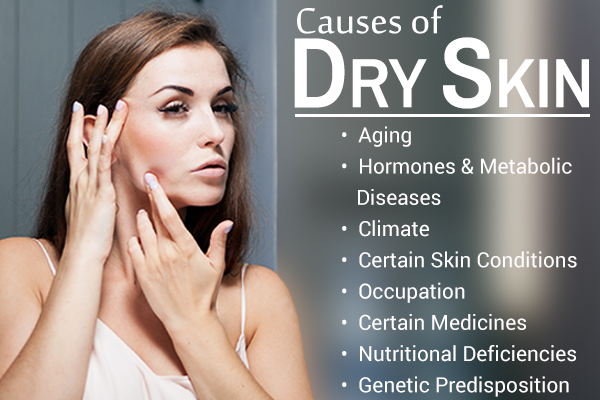In this article:
The skin is the largest organ of the body and acts as the first line of defense between the internal organs and the outside world.

It derives moisture from its intrinsic water and oil content as well as atmospheric humidity. Dry skin, or xerosis, occurs when the epidermis, which is the topmost layer of the skin, does not retain this moisture.
Dry skin is common in people of all ages, but its severity and extent may vary.
Causes of Dry Skin

The three major mistakes that contribute to xerosis include:
1. Lack of skin moisturization
People who do not regularly moisturize their skin with a suitable emollient are more likely to develop xerosis, for obvious reasons.
2. Excessive skin cleanliness
Excessive skin cleanliness can strip away the natural moisture from the skin, making it dry and irritated. A lot of people over scrub and overuse soaps and detergents to purify their skin. These practices damage the skin barrier and further add to the dryness.
3. Not drinking enough water
Not drinking enough water regularly dehydrates the skin and body.
Other factors that can make the condition worse include:
- Natural decline in the production of collagen with increasing age (1)
- Hormonal imbalance due to menopause or other reasons (2)
- Metabolic diseases such as diabetes, malnutrition, hyperthyroidism, hypothyroidism, and Sjogren’s syndrome
- Cold and dry climate (3)
- Skin conditions such as eczema, ichthyosis, contact dermatitis, and psoriasis
- Occupations that require constant contact with water or frequent handwashing, such as nurses, hairstylists, and professional swimmers
- Swimming in pools
- Certain topical and oral drugs, such as diuretics and retinoids
- Nutritional deficiencies
- Genetic predisposition to dry skin
Symptoms of Dry Skin
Xerosis, or dry skin, can manifest differently in different people, but it usually exhibits the following symptoms in varying degrees:
- Dry skin that is rough and scaly to touch
- Dull and flaky skin
- Fine lines that are more accentuated than before
- Intense, localized dryness, which can extend to the deeper layers of the skin, causing skin rupture and bleeding
- Chapped or cracked lips, which can sometimes bleed
- Fishnet-like cracks on the hands, feet, and lips
- Skin that feels unusually tight after exposure to water
- Greyish skin in dark-complexioned people
- Severe itching, which is particularly worst around the waist, lower legs, back, and abdomen
Treatment for Dry Skin
Skin dryness can result from a variety of factors and the choice of treatment can vary depending upon the underlying cause. However, some of the most commonly recommended measures to treat dry skin include:
1. Moisturizers
If you have extremely dry skin, the doctor may recommend a moisturizer that contains hyaluronic acid. This high-viscosity substance imparts moisture to the skin and locks it down to maintain a healthy water balance in the skin cells.
2. Medicines
If your skin becomes severely dry or inflamed or the condition spreads to large areas of the body, your doctor may prescribe a topical corticosteroid or an immune modulator, such as tacrolimus and pimecrolimus, to bring down the inflammation and relieve the itch.
Diagnosing Dry Skin

Your dermatologist will recommend the proper treatment for dry skin based on its root cause.
To determine the reason behind the dryness, the doctor will carefully examine your skin and inquire about your habits, skin care routine, and medical history to get further insights into the condition.
You may have to undergo specific tests if the doctor suspects that an underlying health problem is causing the dryness.
When there is a rash, a biopsy may be conducted, wherein a small portion of the affected skin tissue is analyzed to reach a conclusive diagnosis.
Can Dry Skin Be a Sign of Dehydration?
An estimated 20% of your body’s total water content is stored in the skin and 60%–70% of this reserve accumulates in the topmost layer. A well-hydrated body is an important prerequisite for a well-hydrated skin, whereas dry skin is one of the foremost signs of dehydration.
Complications
If left untreated, xerosis can cause significant skin damage that may be difficult to undo. The complications of dry skin include:
- Excessive itching and the consequent rubbing or scratching can make the affected skin increasingly rough and thick (lichenification).
- Dry and thick skin is more likely to develop agonizing cracks, especially in the exposed areas of the body, such as the hands and feet.
- Xerosis can lead to more severe skin problems such as eczema or dermatitis in the absence of proper care. These conditions are characterized by the appearance of red, round spots all over the body that are rough, scaly, and itchy.
- At times, the scratch sites may get infected with bacteria. Such an infection is characterized by yellow crusts filled with pus. Seek the help of a medical professional in such a case.
Moreover, there is always the possibility that chronic xerosis may be triggered by a serious underlying systemic disease such as diabetes mellitus, end-stage renal disease, human immunodeficiency virus (HIV), hypothyroidism, and liver disease. In cases like these, timely treatment is needed.
When to See a Doctor
Dry skin often causes itching, which may, at times, become troublesome. If the itching becomes too severe and persists for longer than 2 weeks without any apparent reason to justify it, seek medical help immediately.
Consult a doctor if:
- Preliminary treatment for 5 days or more fails to provide any noticeable relief.
- The dryness-induced itching keeps you up at night.
- Your skin starts to peel or you develop open fissures or ring-shaped rashes on the affected skin.
- Your skin starts to itch without any visible rash or flakiness.
- The affected skin becomes red, swollen, and warm to the touch and starts oozing discharge, all of which are indicative of an infection.
- You run a fever.
- You are an older adult who is experiencing severe unabated itching for more than 2 weeks at a stretch without any discernible cause.
Final Word
The condition of your skin reflects your internal health, and therefore problems such as xerosis should be taken seriously and not merely as a cosmetic concern. If your skin appears dry and flaky, it means your body is not getting its required water supply.
Moreover, a lack of moisture in the skin compromises its structural integrity, making it more prone to damage. Both external hydration and internal hydration are very important to keep your skin soft and supple.
Follow a stringent skin care routine that involves regular cleaning, toning, and moisturizing, but do not overdo it. Excessive moisturizing or cleaning can worsen your skin condition. If you fail to register any relief despite proper skin care and fluid intake, consult your doctor for a thorough evaluation and required treatment.

- Was this article helpful?
- YES, THANKS!NOT REALLY


